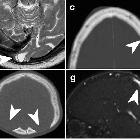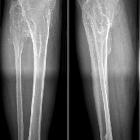Foramina parietalia permagna









 nicht verwechseln mit: bilateral thinning of the parietal bones
nicht verwechseln mit: bilateral thinning of the parietal bonesGiant parietal foramina are a type of congenital calvarial defect. They result from delayed/incomplete ossification of the parietal bone in the region of the parietal formaen.
Pathology
They can occur as an isolated autosomal dominant trait or as part of a syndrome. Ossification along a midline bar may separate confluent parietal defects into paired parasagittal defects during the first few months of life, which can persist into adult life.
Genetics
Underlying genetic anomalies have been identified in chromosome 11p deletions with mutation of the ALX4 (60%) and MSX2 (40%) genes in those with enlarged parietal foramina.
Associations
Increased incidence of venous and cortical anomalies. Bilateral parietal foramina are associated with Potocki-Shaffer syndrome.
Radiographic features
Fetal diagnosis
Second trimester ultrasound (or MRI) may identify the calvarial defects.
CT
Seen as paired, rounded defects in the parietal bone located near the intersection of the sagittal and lambdoid sutures. The defects may be large and confluent across the midline.
MRI
Superior to CT for detecting any associated cortical, venous or meningeal anomalies.
Treatment and prognosis
They are generally considered benign. Small foramina are sometimes even considered being part of the spectrum of normal variation. Some authors, however, suggest imaging of underlying brain parenchyma and vasculature in those with enlarged parietal foramina (>5 mm) due to high associations with cortical and venous anomalies .
Siehe auch:
- Multiple kartilaginäre Exostosen
- Sinus pericranii
- bilaterale parietale Ausdünnung Schädelkalotte
- Foramen parietale
- Ritscher-Schinzel-Syndrom
- Foramina parietalia mit kleidokranialer Dysostose
- Potocki-Shaffer-Syndrom
- frontal foramina
- FG-Syndrom
- Toriello-Syndrom
und weiter:

 Assoziationen und Differentialdiagnosen zu Foramina parietalia permagna:
Assoziationen und Differentialdiagnosen zu Foramina parietalia permagna:



